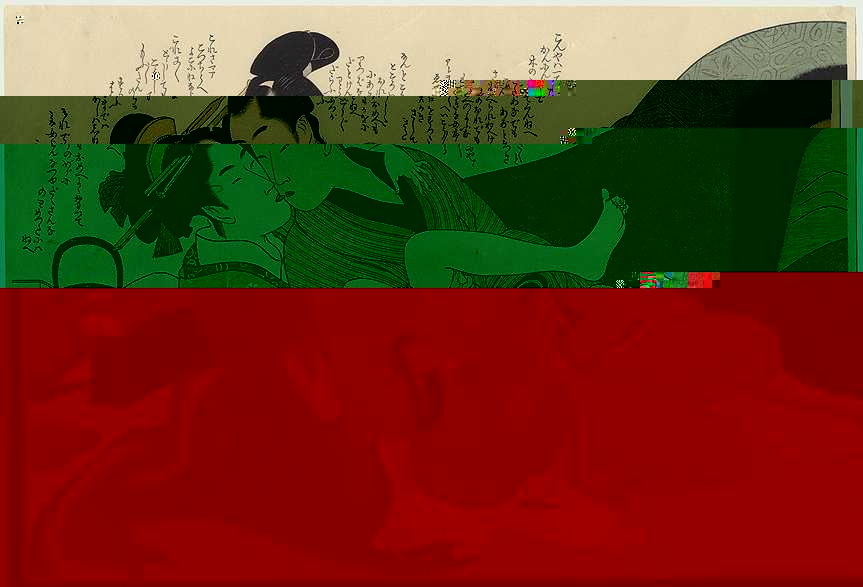
“But even if the internet is dead this doesnt mean it's over. It is all over.”
When we met recently we talked about the glitch as it relates to contemporary image culture, but we also talked about the glitch as something to aspire to. In your essay, A Thing Like You and Me, you retell Walter Benjamin’s parable of the Angel of History, pushed by the harsh winds of progress away from the rubble of history, its back facing into the unknown future. You say that we are the rubble, or at least, that we should align ourselves with the rubble. I’m fascinated by these allusions to excess and detritus in your writing, and I see something of the glitch aesthetic making its way into your video works. I thought we could start from these bruises and cracks; from the things we can’t predict, control or maintain. How would you relate the glitch to Benjamin’s rubble?
One of the biggest misunderstandings about digital information is that it is replicated identically, without loss or transformation. But anyone who works with such information knows that digital practice is constituted – like perhaps any technology – by malfunction. One has to constantly convert information in order to work with it across different platforms and softwares and on the way it is reformatted, translated, compressed or sometimes even blown up, it is enhanced or diminished: it changes. It changes its format or container or outlook or context.
Digital information is thus characterised by transformation, degradation, circulation, but also by its surprising ability to mutate and produce unpredictable results. The glitch, the bruise of the image or sound testifies to its being worked with and working; being passed on and circulated, being matter in action. History inscribes itself into the image in forms of bruises and scars. In their 1958 essay “Les Statues meurent aussi” Chris Marker and Alain Resnais write that the forces of heaven and earth are getting caught up in the scars of African statues. But all imaginable forces – aesthetic, political, technological, affective, social – are expressed by the scars of the digital image or sound. It condenses the tensions and contestations that constitute the image/sound and rip it open.
Glitches expose us to the inner dynamism of the digital, but I wonder what it is about the current conditions of our society that tend to turn us away from the tensions and contestations locked up there in the first place? Chris Marker and Alain Resnais impelled the ‘dead statues’ of their film to live again, turning colonial trophies into emotionally rendered subjects before the camera lens. The forces that compelled the statues to die in Western museums were, perhaps by definition, unable to render their scars as outward signs of anything.
Yes, we do have the same tension nowadays on many levels of the digital world. Marker and Resnais' film died just the same as the statues – not by commodification and colonialism as the African statues they are describing in their film, but by the wholesale commodification of cinema in the context of post 89 transitions. Their film literally became invisible as its infrastructure was destroyed by a neoliberal revolution that also changed the world of images and media. But it came back in form of YouTube files replete with artifacts, cut up and dispersed in fragments across the web to live again - if only for another while. But of course a similar dynamics repeats online, too and the growing development of the web as a tool for surveillance and conformism will force many of its most interesting phenomena to undergo similar deaths and rebirths in different aggregate states. The statues found a new life in film; the film found a new life as file: let’s see what’s going to happen to the files once they too will be forced to change and reformat within different states of matter.

“Is it an impulse of data, sounds and images to surpass the boundaries of information channels and to manifest”
Digital images feature highly in your work, as poor and bruised icons to their own dissemination; as quasi-subjects, devoid of the illusions of the flesh, and all the better for it. In the title of your collection of essays, The Wretched of the Screen, I hear echoes of Georges Duhamel, who saw the spectacle of cinema as "a pastime for helots, a diversion for uneducated, wretched, worn-out creatures" (referenced by Walter Benjamin). I also read a direct reference to Frantz Fanon's work, The Wretched of Earth. For Duhamel the masses were subjugated by the flickering images of popular-culture, and for Fanon, by the machinery of colonialism. For Fanon, at least, there was hope in the lumpenproletariat: the abject peasant class, forgotten by industrial rule and, perhaps, beyond psychological subjugation. The only hope of revolution lay with them. In your essay In Defense of the Poor Image, it is images themselves that are wretched, beyond redemption as subjects. Do you see the digital image as a contemporary lumpenproletariat? In what ways are images, and in turn we, subjugated by the flickering of the screen?
The poor image expresses the full ambivalence of Fanons idea of lumpenproletarians, which Arendt already beautifully and much more precisely described as mob in her “Elements of Totalitarianism”. The mob does not consist of the underclasses, but the “refuse of all classes”. The mob is composed of people expelled into a world characterised by violent colonialism, the expansion of industrial capitalism and subjugation; it is unable to make up its mind, distracted, easily corrupted, or rather corrupt by definition and always ready to betray anybody and everything in order to suck up to the elite. In the current moment of globalisation I see a new mob: people who cannot form a class but constitute the refuse of all classes. A mob of freelancers/mercenaries, moving from one country to another, trying to flee the devastations that finance capitalism and algorithms on the loose create, roaming the suburbs and lowlands of the web, scamming, spamming, phishing, pirating and otherwise trying to stay afloat in a fleeting world of dislocated images. Many artists belong to this category, too. Poor images express similar tensions – in the aggregate state of files. A visual mob, defined by mobility and mobilisation, spreading Hollywood preview copies with the same nonchalance as ads for penis enlargement or insurrectionary manifestoes. Contemporary digital mobs are subjected to similar states of compression and capture.
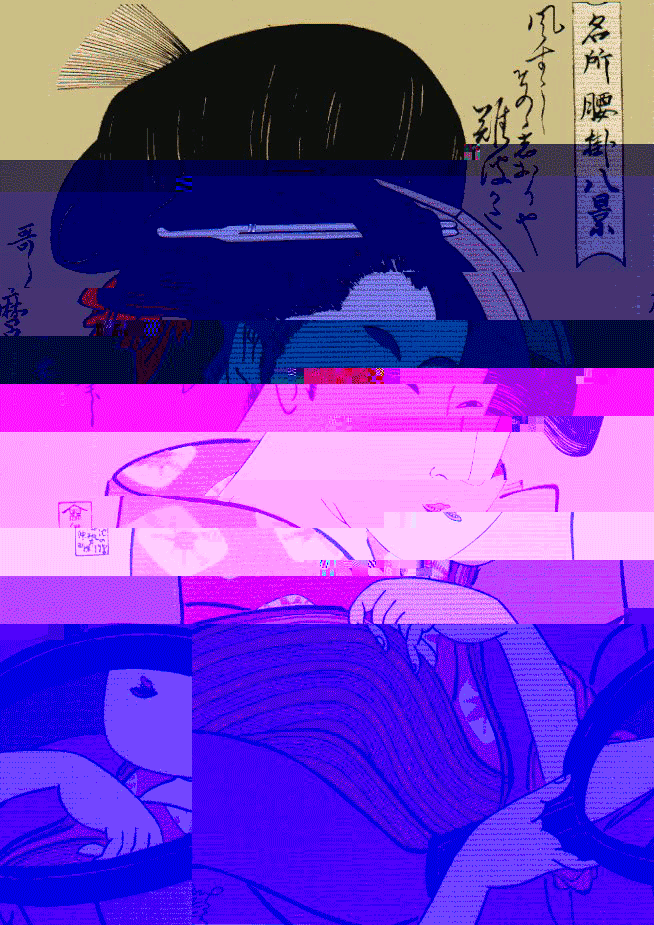
But this kind of images is not a new phenomena. We already see it in a certain genre of wood cuts from the floating world or ukiyo of the Edo period. The ukiyo was the world of fleeting beauty and the hardship of sex work. It was also the world of countless cheap images being reproduced by printing presses, of whores, wrestlers, actors and idols, a world which was essentially fluid and full of unstable reproductions. It was considered “low” art, disposable, defined by circulation and affect.
Claire Bishop expressed concerns late last year that contemporary art had not successfully articulated the ‘digital condition’, yet her argument still pandered to modes of dissemination and display most compatible with the context of the gallery. Today the majority of image production, dissemination, and commentary takes place online. It strikes me that the best place to go to grapple with the digital condition is not the art gallery, but tumblr, youtube and even 4chan. What place does art have in confronting the digital, when today’s most successful digital expressions apparently come from contemporary art outsiders?
I hardly followed the debate around Bishop's text. But it seems to me that she very correctly described a quite ludicrous analog nostalgia in a specific corner of the artworld. Next time I see another 16mm film projector rattling away in a gallery I will personally kidnap it and take the poor thing to a pensioners home. There is usually no intrinsic reason whatsoever for the use of 16mm film nowadays except for making moving images look pretentious, expensive and vaguely modernist, all prepackaged with a whiff of WASPish art history. It made sense to use Bolexes in 1968, and indeed people used them to brilliant end. But today people use cellphones, Kinnect sensors and After Effects to deal with the present and shape it. And if artists do not expose themselves to the workflow and economies that come with contemporary means of production, they become souvenir peddlers. Or worse trying to conveniently package a bygone radical moment as a collectors item. I think Bishop said something similar more politely. Now I also understand people have been disappointed that she´s not been mentioning real contemporary practices more extensively. This complaint should be made to Artforum, though or in extension to the formally and technologically conservative artworld it represents, not to a single writer which isnt an expert in media art and never claimed to be. The debate expresses a real tension, which on the other hand is not so new either. The most interesting and challenging contemporary art was rarely acknowledged as such in it's time and often took place outside the artfield. So the real question is: could one build something outside of the existing artworlds? With what means? It's happening as we speak, because people fortunately don’t usually care what Artforum thinks they should do or even about art as such. It´s happening as you said on tumblr and sites like jogging and many others. Its massively happening in the streets of Syria and Egypt, which are or recently were vanguard laboratories of new media development, with the online dissemination of protests and actions against sexual violence from Delhi to Stupidville or slave labour in the artworld. New media are brought into the world through contemporary social conflicts by the midwifes of violence, boredom, perpetual distraction. Enhanced by rumour and glamour, by uncertainty and intense speculation. Into an aggregate state of matter which is beyond art or the next art or non-art or after art as David Joselit wrote: expressing the tensions of globalising media worlds within post-democracy and accelerated capitalism. Its artifacts may be art or facts.
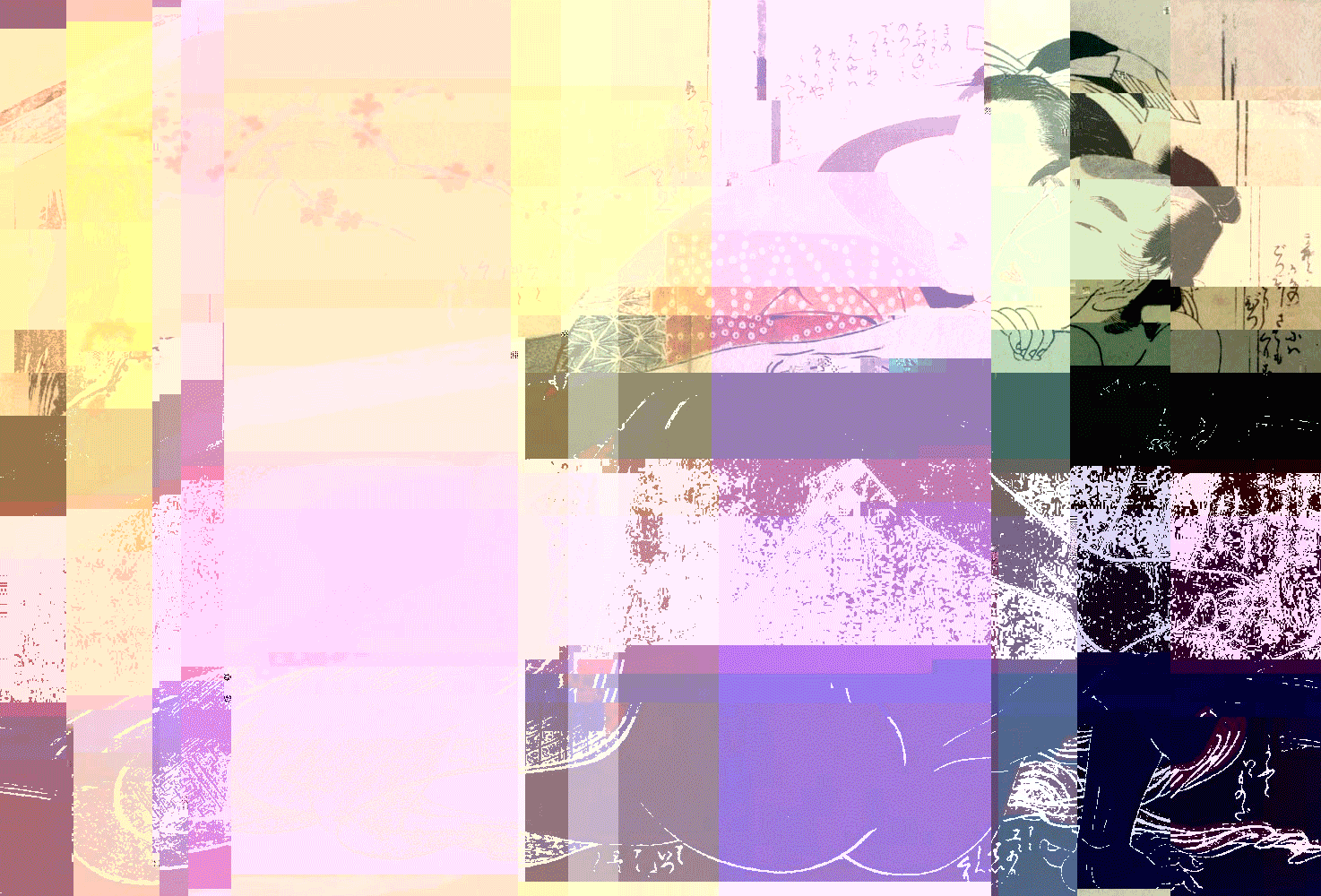
Another important question: many contemporary artworlds are irrevocably digital; beyond their incorporation of digital art. Their infrastructure and whole mode of operation deeply relies on digital technology. People dropbox their works which unfold in galleries like inflatable chutes. But this economy is also fundamentally based on digital technology, including hedging, betting, reputation engineering, accelerating circulation, aggregating jpegs, tele-exploiting interns, regurgitating 3D point clouds as deconstructive atriums where weapon manufacturers and oligarchs hang their dot paintings. This is the digital base of the artworld; embedded in its modes of operations.
In December I was lucky enough to visit your exhibition at the Chicago Institute of Art which showcased three new works, Abstract, Adorno’s Grey and Guards. In particular I was drawn towards Guards, perhaps because it focussed so clearly on its two subjects, Ron Hicks and Martin Whitfield. As the camera follows Ron around the Chicago gallery, pursuing an imaginary assailant, the messy politics of the art institute became exposed to me. It struck me that subjects are usually more hidden in your video work, or at least, the emphasis of your work acts to distort and dislocate human subjects. I see this in your work In Free Fall, where you map the biography of the Boeing 707 aircraft, but also in more personal works such as November, 2004, in which the central identity of your friend Andrea Wolf is never quite pinned down. I wondered then if we could finish by talking about the relationship between subjects and objects. What is it about the current time that seems to draw you towards the object?
Whoever is an image is an object. Whoever is not an image raise their hand. Images have permeated our environments since long time ago. They crossed screens and incarnated: as junkspace, and all sorts of 3D spam. They materialised in form of our own bodies. Images do not represent reality, they create reality, they are second nature. Things among other things, image-objects, image-events, image-situations, images-bodies.
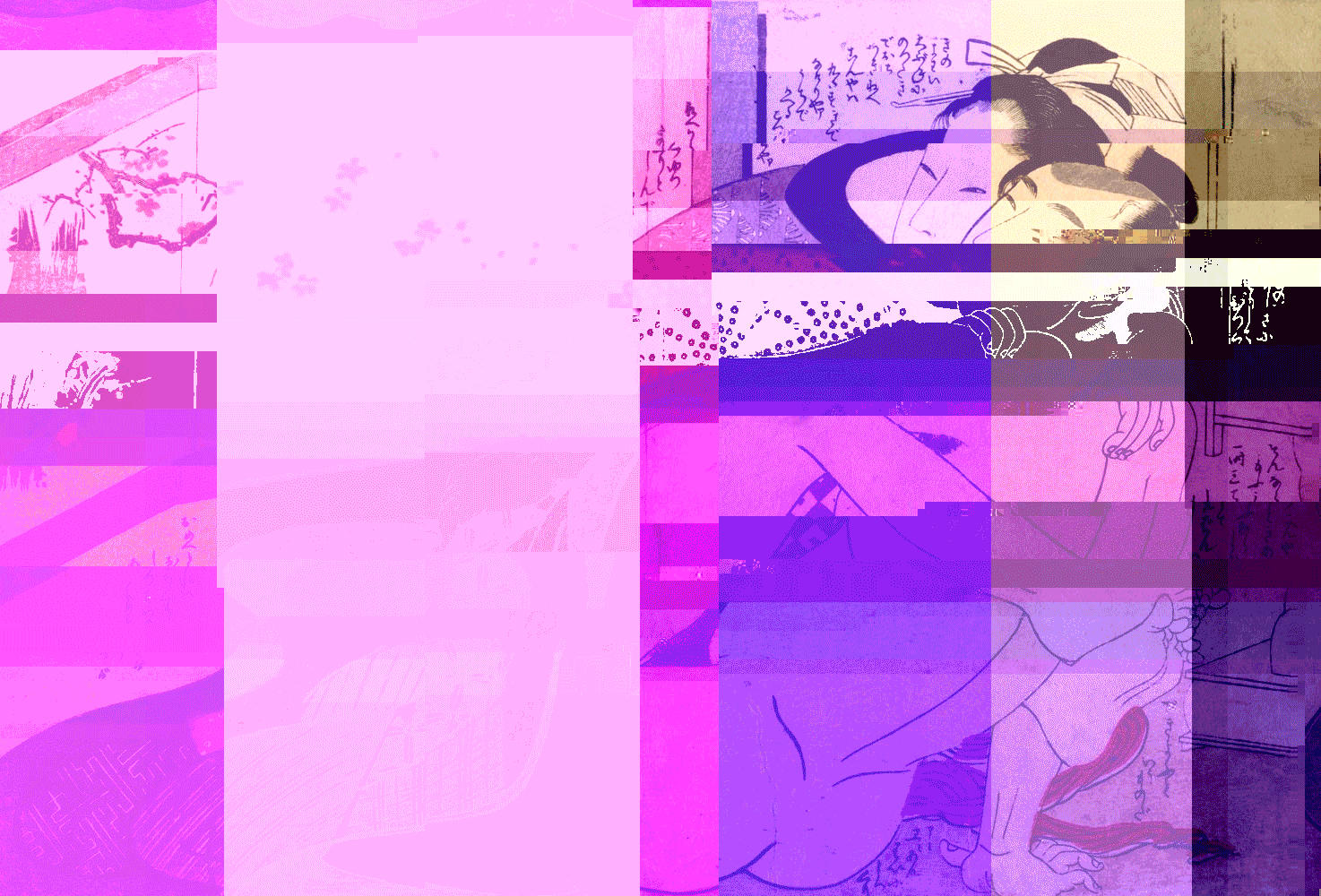
As to the protagonists of many of my videos, probably all of them inhabit at least two very different realms and negotiate the tensions between them. Andrea Wolf is both a martyr and a trash film heroine, the museum officers take their experiences of urban violence and warfare to a sanitised bourgeois White Cube, Mike Potter in “Free Fall” is both a shrewd scrap salesman and Hollywood consultant, Adorno´s Grey´s photographer is superimposed on an anonymous protester breaking through police lines using “Negative Dialectics” as a weapon. One could go on to extend the list… All of them including the crew and myself are both image and agents, quite uncontrollably and sometimes violently propelled into circulation, participating in images instead of controlling, reading, viewing or directing them. Sometimes one of us manages to twist it´s kinetic energy and to direct it back in a kind of jiu-jutsu move. Other times one can just try to enjoy the ride.
The protagonists of your works are buffered by tensions beyond their control and they act regardless. Perhaps the ride takes us back to where we started, the glitch: that unexpected fold or tear manifest for a moment on the surface of a complex substrate; the actions of images?
I don’t care about what image/objects essentially are or represent. I'm fascinated about what we/they do and what happens along the way, about the interactions amongst image/objects and image/situations.
So it’s not about object-ontologies but image-actions, image-gestures, thing-affinities, chains of reaction of objects, forces, and pixels, that manifest in scars and bruises, but also sometimes in the liquid harmony of the floating world of images.
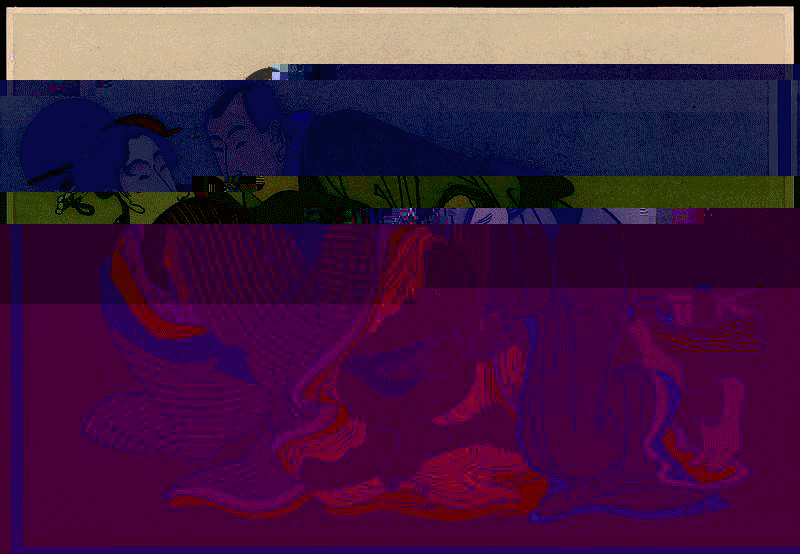
Utamaro and Shunga JPEGs databent in an impromptu collaboration between Daniel Rourke, Hito Steyerl, and her texts. Glitchy GIF responses by Benjamin Berg (stAllio!).

